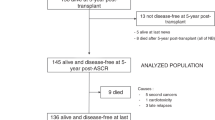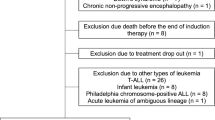Abstract
Due to the poor prognosis of high-risk (HR) neuroblastoma (NBL), scant data exist on late effects after treatment. Recently, protocols utilizing intense multimodal treatment have resulted in improved long-term survival. The objective of this study was to determine the prevalence of late effects in survivors of HR NBL. A retrospective review of clinical data for serial patients completing treatment between September 1994 and October 2007 and surviving for at least 1 year was performed. Therapy included aggressive chemotherapy, surgery, radiation and single or tandem SCT. Oncology follow-up was standard; clinical criteria were utilized for referrals to endocrinology and other services. Fifty-one eligible patients were identified. Median follow-up was 6.1 years (range 1.0–15.2). Height was significantly impacted (ΔZ-score −1.91 in those treated with TBI and −0.77 in those without). Pre-diabetes or diabetes, hypothyroidism and ovarian insufficiency were observed in 50, 59 and 75% of at-risk survivors, respectively. Hearing loss and dental issues were common. Nine patients had relapse of NBL; seven died of progressive disease. As there is a high prevalence of late effects in long-term survivors of HR NBL, close monitoring and further studies after treatment are indicated, and in particular after more modern, non-TBI regimens.
This is a preview of subscription content, access via your institution
Access options
Subscribe to this journal
Receive 12 print issues and online access
$259.00 per year
only $21.58 per issue
Buy this article
- Purchase on Springer Link
- Instant access to full article PDF
Prices may be subject to local taxes which are calculated during checkout




Similar content being viewed by others
References
Bowen KA, Chung DH . Recent advances in neuroblastoma. Curr Opin Pediatr 2009; 21: 350–356.
Brodeur GM, Pritchard J, Berthold F, Carlsen NL, Castel V, Castelberry RP et al. Revisions of the international criteria for neuroblastoma diagnosis, staging, and response to treatment. J Clin Oncol 1993; 11: 1466–1477.
Matthay KK, Villablanca JG, Seeger RC, Stram DO, Harris RE, Ramsay NK et al. Treatment of high-risk neuroblastoma with intensive chemotherapy, radiotherapy, autologous bone marrow transplantation, and 13-cis-retinoic acid. Children's Cancer Group. N Engl J Med 1999; 341: 1165–1173.
George RE, Li S, Medeiros-Nancarrow C, Neuberg D, Marcus K, Shamberger RC et al. High-risk neuroblastoma treated with tandem autologous peripheral-blood stem cell-supported transplantation: long-term survival update. J Clin Oncol 2006; 24: 2891–2896.
Brodeur GM, Hogarty MD, Mosse YP, Maris JM . Neuroblastoma. In: Pizzo PA, Poplack DG (eds). Principles and Practice of Pediatric Oncology 5th edn. Lippincott Williams & Wilkins: Philadelphia, 2006.
Laverdiere C, Cheung NK, Kushner BH, Kramer K, Modak S, LaQuaglia MP et al. Long-term complications in survivors of advanced stage neuroblastoma. Pediatr Blood Cancer 2005; 45: 324–332.
Flandin I, Hartmann O, Michon J, Pinkerton R, Coze C, Stephan JL et al. Impact of TBI on late effects in children treated by megatherapy for Stage IV neuroblastoma. A study of the French Society of Pediatric oncology. Int J Radiat Oncol Biol Phys 2006; 64: 1424–1431.
Hobbie WL, Moshang T, Carlson CA, Goldmuntz E, Sacks N, Goldfarb SB et al. Late effects in survivors of tandem peripheral blood stem cell transplant for high-risk neuroblastoma. Pediatr Blood Cancer 2008; 51: 679–683.
Kuczmarski RJ, Ogden CL, Guo SS, Grummer-Strawn LM, Flegal KM, Mei Z et al. 2000 CDC Growth Charts for the United States: methods and development. Vital Health Stat 11 2002; 246: 1–190.
American Diabetes Association. Diagnosis and classification of diabetes mellitus. Diabetes Care 2010; 33: S62–S69.
Hovi L, Saarinen-Pihkala UM, Vettenranta K, Lipsanen M, Tapanainen P . Growth in children with poor-risk neuroblastoma after regimens with or without total body irradiation in preparation for autologous bone marrow transplantation. Bone Marrow Transplant 1999; 24: 1131–1136.
Trahair TN, Vowels MR, Johnston K, Cohn RJ, Russell SJ, Neville KA et al. Long-term outcomes in children with high-risk neuroblastoma treated with autologous stem cell transplantation. Bone Marrow Transplant 2007; 40: 741–746.
Perwein T, Lackner H, Sovinz P, Benesch M, Schmidt S, Schwinger W et al. Survival and late effects in children with stage 4 neuroblastoma. Pediatr Blood Cancer 2011; 57: 629–635.
Willi SM, Cooke K, Goldwein J, August CS, Olshan JS, Moshang T Jr. . Growth in children after bone marrow transplantation for advanced neuroblastoma compared with growth after transplantation for leukemia or aplastic anemia. J Pediatr 1992; 120: 726–732.
Olshan JS, Willi SM, Gruccio D, Moshang T Jr. . Growth hormone function and treatment following bone marrow transplant for neuroblastoma. Bone Marrow Transplant 1993; 12: 381–385.
Hobbie WL, Moab SM, Carlson CA, Gruccio D, Ginsberg JP . Prevalence of advanced bone age in a cohort of patients who received cis-retinoic acid for high-risk neuroblastoma. Pediatr Blood Cancer 2011; 56: 474–476.
Smedmyr B, Wibell L, Simonsson B, Oberg G . Impaired glucose tolerance after autologous bone marrow transplantation. Bone Marrow Transplant 1990; 6: 89–92.
Taskinen M, Saarinen-Pihkala UM, Hovi L, Lipsanen-Nyman M . Impaired glucose tolerance and dyslipidaemia as late effects after bone-marrow transplantation in childhood. Lancet 2000; 356: 993–997.
Traggiai C, Stanhope R, Nussey S, Leiper AD . Diabetes mellitus after bone marrow transplantation during childhood. Med Pediatr Oncol 2003; 40: 128–129.
Lorini R, Cortona L, Scaramuzza A, De Stefano P, Locatelli F, Bonetti F et al. Hyperinsulinemia in children and adolescents after bone marrow transplantation. Bone Marrow Transplant 1995; 15: 873–877.
Hoffmeister PA, Storer BE, Sanders JE . Diabetes mellitus in long-term survivors of pediatric hematopoietic cell transplantation. J Pediatr Hematol Oncol 2004; 26: 81–90.
Meacham LR, Sklar CA, Li S, Liu Q, Gimpel N, Yasui Y et al. Diabetes mellitus in long-term survivors of childhood cancer. Increased risk associated with radiation therapy: a report for the childhood cancer survivor study. Arch Intern Med 2009; 169: 1381–1388.
van Santen HM, de Kraker J, van Eck BL, de Vijlder JJ, Vulsma T . High incidence of thyroid dysfunction despite prophylaxis with potassium iodide during (131)I-meta-iodobenzylguanidine treatment in children with neuroblastoma. Cancer 2002; 94: 2081–2089.
Boulad F, Bromley M, Black P, Heller G, Sarafoglou K, Gillio A et al. Thyroid dysfunction following bone marrow transplantation using hyperfractionated radiation. Bone Marrow Transplant 1995; 15: 71–76.
Faraci M, Barra S, Cohen A, Lanino E, Grisolia F, Miano M et al. Very late nonfatal consequences of fractionated TBI in children undergoing bone marrow transplant. Int J Radiat Oncol Biol Phys 2005; 63: 1568–1575.
Shalitin S, Phillip M, Stein J, Goshen Y, Carmi D, Yaniv I . Endocrine dysfunction and parameters of the metabolic syndrome after bone marrow transplantation during childhood and adolescence. Bone Marrow Transplant 2006; 37: 1109–1117.
Ishiguro H, Yasuda Y, Tomita Y, Shinagawa T, Shimizu T, Morimoto T et al. Long-term follow-up of thyroid function in patients who received bone marrow transplantation during childhood and adolescence. J Clin Endocrinol Metab 2004; 89: 5981–5986.
Sanders JE, Buckner CD, Amos D, Levy W, Appelbaum FR, Doney K et al. Ovarian function following marrow transplantation for aplastic anemia or leukemia. J Clin Oncol 1988; 6: 813–818.
Sarafoglou K, Boulad F, Gillio A, Sklar C . Gonadal function after bone marrow transplantation for acute leukemia during childhood. J Pediatr 1997; 130: 210–216.
Parsons SK, Neault MW, Lehmann LE, Brennan LL, Eickhoff CE, Kretschmar CS et al. Severe ototoxicity following carboplatin-containing conditioning regimen for autologous marrow transplantation for neuroblastoma. Bone Marrow Transplant 1998; 22: 669–674.
Shargorodsky J, Curhan SG, Curhan GC, Eavey R . Change in prevalence of hearing loss in US adolescents. JAMA 2010; 304: 772–778.
Bekes K, Francke U, Schaller HG, Kuhnt T, Gerlach R, Vordermark D et al. The influence of different irradiation doses and desensitizer application on demineralization of human dentin. Oral Oncol 2009; 45: e80–e84.
Holtta P, Alaluusua S, Saarinen-Pihkala UM, Wolf J, Nystrom M, Hovi L . Long-term adverse effects on dentition in children with poor-risk neuroblastoma treated with high-dose chemotherapy and autologous stem cell transplantation with or without total body irradiation. Bone Marrow Transplant 2002; 29: 121–127.
Kaste SC, Goodman P, Leisenring W, Stovall M, Hayashi RJ, Yeazel M et al. Impact of radiation and chemotherapy on risk of dental abnormalities: a report from the Childhood Cancer Survivor Study. Cancer 2009; 115: 5817–5827.
Carpentieri SC, Diller LR . Neuropsychological resiliency after treatment for advanced stage neuroblastoma. Bone Marrow Transplant 2005; 35: 1117–1122.
Elmlinger MW, Kuhnel W, Weber MM, Ranke MB . Reference ranges for two automated chemiluminescent assays for serum insulin-like growth factor I (IGF-I) and IGF-binding protein 3 (IGFBP-3). Clin Chem Lab Med 2004; 42: 654–664.
Acknowledgements
We would like to thank Henry Feldman, PhD for his statistical advice; and Terence Law in the Department of Laboratory Medicine, Boston Children’s Hospital for his help with assay methods and correlations. This work was supported in part by the Friends for Life Foundation.
Author information
Authors and Affiliations
Corresponding author
Ethics declarations
Competing interests
The authors declare no conflict of interest.
Rights and permissions
About this article
Cite this article
Cohen, L., Gordon, J., Popovsky, E. et al. Late effects in children treated with intensive multimodal therapy for high-risk neuroblastoma: High incidence of endocrine and growth problems. Bone Marrow Transplant 49, 502–508 (2014). https://doi.org/10.1038/bmt.2013.218
Received:
Revised:
Accepted:
Published:
Issue Date:
DOI: https://doi.org/10.1038/bmt.2013.218
Keywords
This article is cited by
-
Advancing therapy for neuroblastoma
Nature Reviews Clinical Oncology (2022)
-
Long-term follow-up of high-risk neuroblastoma survivors treated with high-dose chemotherapy and stem cell transplantation rescue
Bone Marrow Transplantation (2021)
-
Accelerating development of high-risk neuroblastoma patient-derived xenograft models for preclinical testing and personalised therapy
British Journal of Cancer (2020)
-
Patient-derived xenograft models—the future of personalised cancer treatment
British Journal of Cancer (2020)
-
Evaluating growth failure with diffusion tensor imaging in pediatric survivors of high-risk neuroblastoma treated with high-dose cis-retinoic acid
Pediatric Radiology (2019)



